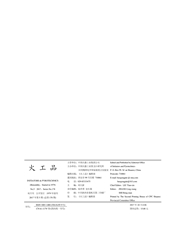

 中文摘要:
中文摘要:
针对液态辛烷/空气两相混合物燃烧波在一维封闭空间内传播时爆燃向爆轰转变(DDT)的问题,运用化学反应流动基本理论、颗粒轨道模型和两步反应模型,在拉格朗日质量坐标系中建立了对该现象的数学表达,并开发了数值模拟程序CTPD,其中气体动力学方程采用显式S^γα,β差分格式,化学反应项使用二阶精度的Adams方法.通过数值模拟研究了液态燃料爆轰波的基本特性,以及点火能量及初始温度对于爆轰波结构与发展的影响.研究发现,点火能量及初始温度的提高显著促进了爆轰的转变,爆轰强度随着点火能量的提高而增大,随着初始温度的提高而减小.研究中计算结果与实验波形符合良好,说明本研究为包括DDT现象在内的脉冲爆轰发动机工作过程提供了一种可行的计算方法.
 英文摘要:
英文摘要:
Mechanism of deflagration to detonation transition (DDT) of liquid octane/air mixture is studied by using theory of one-dimension reacting flow, particle-trajectory model and two-step reaction model, of which the numerical formulation is described on the S^γα,β scheme of "gasdynamic" step and a second-order accurate Adams method of "chemical" step in Lagrangian mass coordination system, based on which code-CPTD is developed. Basic properties of liquid-fueled detonation structure together with the effects of ignition energy and initial temperature of detonable mixtures on detonation structure and development are investigated in our current study. Based on the results obtained numerically, it's found that the increasing of both ignition energy and initial temperature of detonable mixtures in the tube will significantly enhance transition to detonation. Detonation intensity rises with ignition energy, but decreases as initial temperature increases. Our calculations show that the numerical results are in good agreement with experimental ones, which implies that a feasible numerical method has been provided here to simulate pulse detonation engine operation processes including DDT phenomena.
 同期刊论文项目
同期刊论文项目
 同项目期刊论文
同项目期刊论文
 期刊信息
期刊信息
